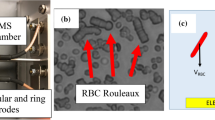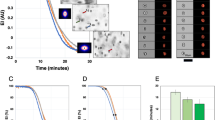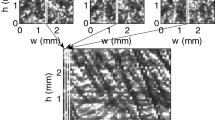Abstract
A SUSPENSION of red blood cells (RBC) in normal saline is characterized by a viscosity dependent on the haematocrit. When RBC at the same haematocrit are suspended in plasma or certain other media, the viscosity of the suspension is higher than that in saline, and the difference is much greater than can be accounted for by that between the viscosities of saline and new suspending medium. This phenomenon has been called the “viscosity-plus” effect1,2. Although the basis of this effect is not definitely understood, it may be based in part on aggregation of RBC by components of the plasma. Blood viscosity is known to increase when aggregation increases1–3, and aggregation, like the “viscosity-plus” effect, is enhanced as blood flow (rate of shear) decreases1–3. Aggregated RBC in normal blood, however, are thought to disperse completely as shear rates increase to approximately 100 reciprocal seconds3. At greater shear rates, whole blood viscosity is thought by some to depend solely on the viscosity of the plasma4. This communication shows that blood viscosity may be disproportionately large, when related to plasma viscosity, even at shear rates as great as 30,000 reciprocal seconds. Interpretations of the “viscosity-plus” effect must take cognizance of its operation at such high shear rates.
This is a preview of subscription content, access via your institution
Access options
Subscribe to this journal
Receive 51 print issues and online access
$199.00 per year
only $3.90 per issue
Buy this article
- Purchase on Springer Link
- Instant access to full article PDF
Prices may be subject to local taxes which are calculated during checkout
Similar content being viewed by others
References
Gelin, L-E., in Evaluation of Low Molecular Weight Dextran in Shock: Pharmacology and Pertinent Rheology (edit. by Eiseman, B., and Bosomworth, P.), 6 (Division of Medical Sciences, US Nat. Acad. Sci.—Nat. Res. Council, Washington, 1963).
Gelin, L-E., in Cerebral Vascular Diseases, Trans. Fifth Princeton Conf. (edit. by Siekert, R. G., and Whisnant, J. P.), 167 (Grune and Stratton, New York and London, 1966).
Merrill, E. W., and Pelletier, G. A., J. Appl. Physiol., 23, 178 (1967).
Dintenfass, L., Bibliog. Anat., 9, 525 (1966).
Swank, R. L., and Roth, J. G., Rev. Sci. Instrum., 25, 1020 (1954).
Rosenblum, W. I., Blood, 31, 234 (1968).
Rosenblum, W. I., and Asofsky, R. M., J. Lab. Clin. Med., 71, 201 (1968).
Rosenblum, W. I., and Asofsky, R. M., Arch. Neurol., 18, 151 (1968).
Rosenblum, W. I., Nature, 218, 591 (1968).
Gregerson, M., in Evaluation of Low Molecular Weight Dextran in Shock: Pharmacology and Pertinent Rheology (edit. by Eiseman, B., and Bosomworth, P.), 25 (Division of Medical Sciences, US Nat. Acad. Sci.—Nat. Res. Council, Washington, 1963).
Erslev, A. J., and Atwater, J., J. Lab. Clin. Med., 62, 401 (1963).
Chien, S., Usami, S., Dellenback, R. J., Gregersen, M. I., Nanninga, L. B., and Guest, M. M., Science, 157, 829 (1967).
Meiselman, H. J., Merrill, E. W., Gilliland, E. R., Pelletier, G. A., and Salzman, E. W., J. Appl. Physiol., 22, 772 (1967).
Meiselman, H. J., Merrill, E. W., Salzman, E. W., Gilliland, E. R., and Pelletier, G. A., J. Appl. Physiol., 22, 480 (1967).
Wells, C. H., Jenkins, C. W., and Bond, T. P., Program Abstr. Sixteenth Ann. Conf. of the Microcirculatory Soc., Atlantic City (1968).
Rees, S. B., Simon, L., Pelletier, G. A., Balodimos, M., Gleason, R., Marbel, A., and Merrill, E. W., Biorheology, Abstr., 4, 102 (1967).
Wells, R., and Edgerton, H., Angiology, 18, 699 (1967).
Author information
Authors and Affiliations
Rights and permissions
About this article
Cite this article
ROSENBLUM, W. “Viscosity-plus” Effect in Whole Blood at High Shear Rates. Nature 221, 365–366 (1969). https://doi.org/10.1038/221365a0
Received:
Issue Date:
DOI: https://doi.org/10.1038/221365a0
Comments
By submitting a comment you agree to abide by our Terms and Community Guidelines. If you find something abusive or that does not comply with our terms or guidelines please flag it as inappropriate.



